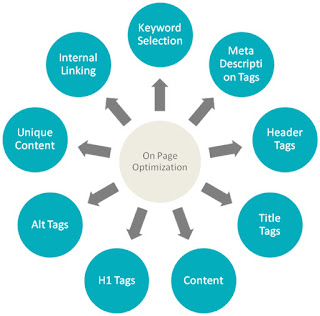On Page Optimization really means optimizing a webpage in a website. Optimizing means making changes to the webpage using different techniques which make the webpage search engine friendly. It is also referred webpage optimization. The optimization is done in order to get high rank in search engines. On page optimization can be done using various techniques.
On Page Optimization Techniques include:
1. Title Tag Optimization
Title is the first
sentence which gives the details about our webpage. Depending on the title the
users will decide whether to visit the webpage or not. Its importance is so
high. So it should be done with special care. It should be meaningful and the
size should be about 512 pixel which is about 55-60 characters. There are
certain things to be remembered while selecting the title. They are:
- Minimum characters in title should be 40.
- Should be error free that means no grammatical errors.
- Should be related to the content
Meta tag description is a description being displayed under the URL. The
characters in the meta description should be 155-160 for a website and should
be 154-155 for blog. If meta description is no being described then google will
take the first line of the content or any other area of the content as meta
description.
3. URL Optimization
URL should be related
to the content and it should be simple and meaningful. Then it will be easier
for google bots in crawling the website. If we are using relevant keyword then
it will be better.
4. Heading Tag Optimization
The heading tags will
improve the presentation of the content. There are different sizes for heading
tags. The highest size is <h1>, then <h2> likewise it is up to h6
which is the least. There are some important things to be remembered in heading
tags. The <h1> tags mainly denotes the main title and should have at
least three words and maximum of eight words. If more than one <h1> is
given then it will create confusion. If <h1> is not there, then content
of<h2> will be taken.
5. Keyword Density
Optimization
Keyword density means
the number of times the keyword is being displayed in the content.Precise usage
is 2-5%. Placing keyword after a ',' or '.' is a good usage because crawlers as
well as users will stop there. It will create
a stress on the keyword.
6. Anchor Text
Optimization
Keywords which is
having a link is referred to as anchortext. It is a reference to the user. It act as a recommendation to
the crawler. Anchor text is created by giving the specified data in <a
href=”...”></a>.
7. Image Optimization
Images can always
create an attraction to the website. It improves the presentation view. It is
difficult for google to identify the description of image by seeing its URL but
if it is added with an alt attribute i.e adding an alternate text to the image
will be very useful.
Another option is to
provide a file name which is related to the content. We can have an option to
add image from other published websites. If we are using that then it should be
specified under the image courtesy which is given at the end of
the post. Surrounding content of the image are also being checked to get the
detail of the image.
All these techniques will make the website to be crawled very easily. If
on page optimization is done efficiently then their is greater chance to
get high position in ranking. I have already published a post on A Glimpse Of Search Engine Optimization Basics which will be helpful in understanding this post
Image Courtesy
1.www.belinked.in
2.flyeasy.org.in
3.indonetworksecurity.com



No comments:
Post a Comment